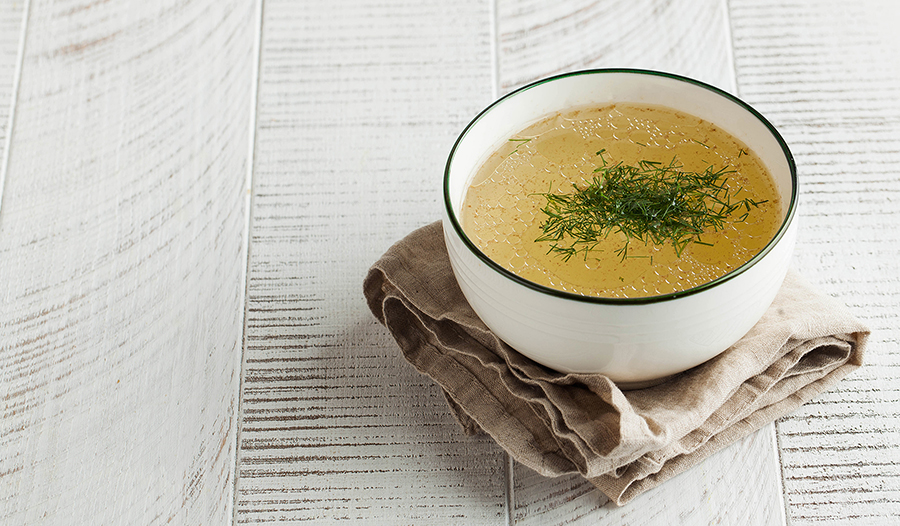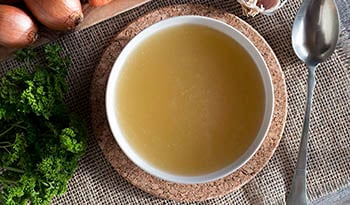6 Health Benefits of Bone Broth + How to Use It
ВІДМОВА ВІД ВІДПОВІДАЛЬНОСТІ:Цей блог не призначений для встановлення діагнозу...
- У цій статті:
- What is Bone Broth and Why is it Still Trendy?
- 1. Good Source of Amino Acids
- 2. Provides Essential Minerals and Other Compounds
- 3. Supports Healthy Immune Function (via Gut Support)
- 4. Can Help Promote Gut Health
- 5. Provides Collagen and Gelatin for Joint Support
- 6. Can Help Support Healthy Skin and Hair
- How to Use Bone Broth
- How to Make Your Own Bone Broth at Home
- How Much Bone Broth Should You Aim to Have Each Day?

It’s my personal philosophy that food is the best choice for maximized health. Some of the simplest, time-honored foods can have the biggest impact on our health. I've certainly found that's the case with real, traditional bone broth.
Chicken bone broth is a nutritious stock that is considered to be an ancient superfood for generally supporting healthy immune function, digestion, respiratory health, joint comfort, and more.
It’s naturally chock full of nutrients and beneficial compounds including collagen (a type of protein made up of 19 amino acids), gelatin, trace minerals like calcium, phosphorus, and magnesium, and sulfur compounds. Additionally, it provides you with chondroitin sulfate and glucosamine, two compounds that are commonly taken in supplement form to help support joint comfort.
What is Bone Broth and Why is it Still Trendy?
Bone broth is a liquid stock made with animal parts including bones, skin, marrow, and connective tissues.
While traditionally-prepared bone broth has been consumed for thousands of years by people living around the globe, more recently it’s become known as a trendy “superfood”— especially among people following the Paleo diet or low carb diets such as the keto diet.
While you might picture someone sipping on stock or broth only during certain times or seasons, we now know that bone broth actually benefits almost every part of your body, no matter your age or health interests, during all times and seasons.
Bone broth is beneficial for people across many ages, lifestyles, and walks of life. It’s one of the few and richest sources of natural collagen, the protein found in vertebrae animals, in their bones, skin, cartilage, ligaments, tendons, and bone marrow.
As bone broth simmers for hours, collagen and gelatin from the animal parts leach into the broth and become readily absorbable for you to consume, which may help your body synthesize its own collagen.
As you’ll learn more about below, consuming collagen becomes even more important as you age, since your body naturally produces less as early as your late 20s or early 30s. Because collagen forms healthy connective tissues, increasing your intake of collagen and other compounds from bone broth can help promote joint health, while also supporting the health of other your gut, ligaments, skin, and hair.
Health Benefits of Bone Broth
1. Good Source of Amino Acids
There are dozens of different nutrients found within bone broth, including 19 different amino acids (often described as the “building blocks of protein”). While protein sources like meat and fish contain every amino acid, they aren’t high in the types found in bone broth.
Bone broth contains collagen protein — which is made up of amino acids like glycine, arginine, proline, and glutamine — that can’t be obtained easily in high amounts from other commonly eaten foods. That’s partly why there are so many incredible bone broth and collagen benefits.
Amino acids found in bone broth stock have numerous roles, especially when it comes to generally supporting healthy metabolism, gut health, healthy joints, and maintenance of muscle mass.
2. Provides Essential Minerals and Other Compounds
Because it’s made with animal parts that are brimming with nutrients, bone broths contain a number of important minerals, including calcium, phosphorus, and magnesium. These help to support the overall skeletal structure and strong bones.
Within bone broth, you’ll also find sulfur and a number of other health-promoting compounds like chondroitin sulfate, glucosamine, and MSM, which have the potential to support the health of connective tissues including joints.
3. Supports Healthy Immune Function (via Gut Support)
The majority of your immune system is actually located within your gut. It makes sense then that drinking broth — which is higher in collagen/gelatin and the amino acids proline, glutamine, and arginine — can help support a healthy immune system, especially when paired with an antioxidant-rich diet.
4. Can Help Promote Gut Health
Compounds found within bone broth, especially collagen peptides and gelatin, help to support gut health because they play a role in maintaining the integrity of the tissues that line the colon and entire gastrointestinal tract
In addition to supporting gut/intestinal health, compounds within bone broth including amino acids and glutathione can also support healthy gut function.
5. Provides Collagen and Gelatin for Joint Support
During the course of the normal aging process, collagen naturally diminishes in the body, which can affect our joints, connective tissues, bones, and more, leading to lessened flexibility and occasional joint discomfort.
Collagen and gelatin are two valuable components of bone broth because they provide your body with amino acids that can be used to support the integrity of connective tissues and overall joint health, comfort, and mobility.
6. Can Help Support Healthy Skin and Hair
Collagen helps form elastin and other compounds within the skin that help to maintain the skin’s texture and tone. Additionally, bone broth provides amino acids that can help support healthy hair and nails.
How to Use Bone Broth
Today there are many different kinds of bone broths (chicken, beef, and fish for example) to choose from, including the homemade types (you can find these at butcher stores and farmers markets), jarred types, and bone broth powders.
Keep in mind that real bone broth, the type full of collagen and nutrients, is not the same thing as canned or boxed stock, or bouillon cubes used for flavoring soups and meats.
How you use bone broth depends on the exact type you purchase or make. You can use liquid bone broth — whether chicken, beef, or fish broth— in some of these savory types of recipes:
- Classic chicken soup
- Beef soup or stew
- Vegetable soup
- Lentil soup
- Bone marrow soup
- Just about any other type of soup you enjoy
If you prefer instead to use a flavored protein powder made from bone broth, such as chocolate or vanilla bone broth powder, try using it in some of these sweet recipes:
- Smoothies and shakes, for example, made with berries and almond milk
- Pancakes
- Oatmeal
- Muffins and healthy bread
You can choose to make bone broth yourself at home or to take a shortcut and use a store-bought version or a powdered bone broth if you don’t necessarily want to spend that time or effort. When it comes to convenience, protein powders made from bone broth are among the quickest options, plus they still offer all the benefits of real liquid bone broth along with extra protein in a simple-to-mix powder.
How to Make Your Own Bone Broth at Home
The essentials to making bone broth are bones, fat, vegetables, and water, ideally along with an acid such as apple cider vinegar which helps release nutrients from the bones. Some people also choose to add meat. If you’re making beef broth or lamb broth, you should brown any of the leftover meat or organ meat before putting it into a stockpot.
To make homemade beef bone broth, visit a local farmers market, butcher, or online retailer, and purchase grass-fed bones. It’s best to seek out animal products that you know are pasture-fed and free of antibiotics and hormones, this way you avoid consuming any unwanted compounds in your stock.
For a chicken bone broth, simply use the carcass and bones from your already cooked chicken. While vegetables are not necessary to make broth, there’s reason to believe that a combination of animal products and vegetables/herbs (such as garlic, onion, celery, carrot, parsley, etc.) can have amplified effects that further boost the nutrient content of the stock.
Here are basic directions for making homemade bone broth:
- Place bones into a large stockpot or slow cooker and cover with water.
- Add two tablespoons of apple cider vinegar to water prior to cooking. This helps pull out important nutrients from the bones.
- Fill stockpot or slow cooker with filtered water. Leave plenty of room for water to boil.
- Heat slowly. Bring to a boil and then reduce heat to simmer for at least six hours. Remove the “foam” as it arises.
- Cook slow and at low heat. Chicken bones can cook for 24 hours. Beef bones can cook for 48 hours. Low and slow cook time is necessary in order to fully extract the nutrients in and around the bone.
- You can also add in vegetables, such as onions, garlic, carrots, and celery, for added nutrient value.
- After cooking in the slow cooker, the broth will cool and a layer of fat will harden on top. This layer protects the broth beneath. Discard this layer only when you are about to eat the broth.
How Much Bone Broth Should You Aim to Have Each Day?
Most experts recommend consuming eight ounces of bone broth, one to two times daily. This can include bone broth protein you have in recipes such as soups, smoothies or baked goods, or just broth that you sip on as a beverage.
If you decide to split up your intake into 2 servings, try having one in the morning and one with dinner or in between meals.

 Автор: Доктор Джош Екс, натуропатолог, хіропрактик, клінічний спеціаліст
Автор: Доктор Джош Екс, натуропатолог, хіропрактик, клінічний спеціаліст


